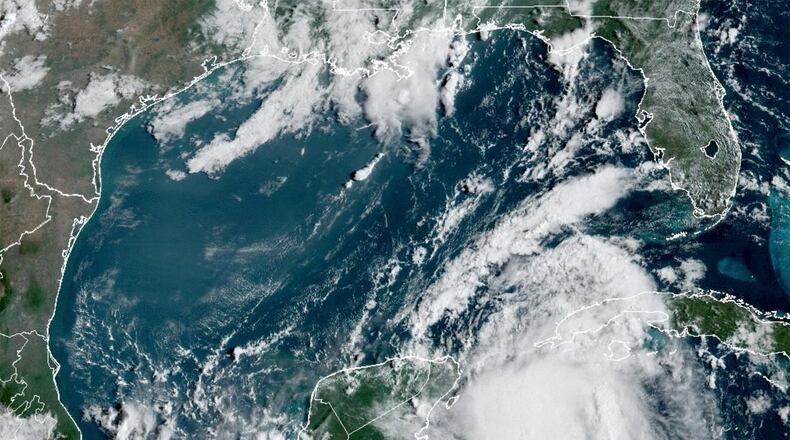With hundreds of millions of dollars worth of peanuts, pecans and cotton sitting in their fields, Georgia farmers are making final preparations for Hurricane Idalia, which could bring damaging winds and rain to parts of the state still scarred from past storms.
As of 2 p.m. Tuesday, Idalia was churning in the Gulf of Mexico 240 miles southwest of Tampa as a Category 1 storm, with sustained winds of about 90 miles per hour. But as the storm continues north over open water, it is expected to rapidly intensify.
Idalia was little more than a loose tropical disturbance days ago, but the storm is gorging itself on gulf waters that are superheated by human-caused climate change and is expected to strengthen dramatically on its final approach.
The federal National Hurricane Center says the storm could reach major hurricane status (Category 3 or greater) with winds of 125 miles per hour or more before it makes landfall Wednesday morning on the Gulf Coast of Florida, most likely north of Tampa. There, it could push a “catastrophic” 10 to 15 feet of storm surge into low-lying areas.
On Monday, President Joe Biden approved federal disaster assistance for Florida and dispatched teams from the Federal Emergency Management Agency to Tallahassee and Atlanta. Georgia Gov. Brian Kemp also declared a state of emergency and directed the Georgia Emergency Management and Homeland Security Agency to activate an operations center to lead the state’s response.
The storm will likely still be packing hurricane force winds when it advances into Georgia Wednesday in the late morning and early afternoon, threatening some of the state’s most valuable crops. That’s bad news for many South Georgia farmers, like Jonathan Mann, the co-owner of GBJ Mann Farms in Surrency, 90 miles southwest of Savannah.
On Monday, Mann was hustling to spray all 800 acres of his peanut farm with fungicide — a three day job that he was trying to pack into just two — in anticipation of the drenching Idalia is expected to deliver.
The strong winds that are projected are a much bigger worry, he said.
In addition to peanuts, Mann has about 1,600 acres of cotton and some pecan groves. The cotton is weeks away from harvest and some bolls have begun to split open, he said, revealing the coveted — but fragile — white material inside.
“Most people would probably like to see some rain this time of year to sort of finish out the crop — that part of it would be a blessing,” Mann said. “But it’s the wind that would have me very concerned.”
Three particularly vulnerable crops in the hurricane’s path each rank among Georgia’s most valuable in cotton, peanuts and pecans.
Mann knows the damage hurricanes can cause all too well. Like many other farmers across South Georgia, he sustained heavy losses in Hurricanes Michael, which came ashore in 2018 as a Category 5 storm, devastating the Florida Panhandle before lashing South Georgia with gusts as strong as 115 miles per hour. The winds knocked down buildings and pecan trees and ripped up row crops, causing losses of $2 billion.
Before Michael came Hurricane Irma in 2017 and Hurricane Matthew in 2016, which both caused major damage on many Georgia farms.
Pam Knox, an agricultural climatologist at the University of Georgia, said that the damage from this storm could fall somewhere in between what was caused by Michael and Irma.
“Both of those (storms) were very significant for agriculture in Georgia, so I expect there to be some issues and I’m sure farmers are quite concerned about it,” she said.
Metro Atlanta is likely to avoid major impacts, but Savannah could see tropical storm force winds, heavy rain and 2 to 4 feet of storm surge, as Idalia pushes up the U.S. East Coast.
Experts say the conditions exist to produce a monster storm, in part due to climate change.
Water temperatures in August in the Gulf of Mexico are always hot, but they have rarely been warmer than they are right now, said Marshall Shepherd, the director of UGA’s atmospheric sciences program. Ocean heat content is the primarily fuel for hurricanes and Idalia is set to encounter waters that are one to two degrees hotter than normal for this time of year, Shepherd said. That could allow wind speeds to increase by 35 miles per hour or more ahead of landfall.
“Scientists like myself have been sitting on eggshells all year long because we knew that the Gulf of Mexico was a powder keg ready to blow,” he said. “And if a storm got into the Gulf of Mexico, like Idalia is going to do, we know that there’s potential for significant rapid intensification.”
A note of disclosure
This coverage is supported by a partnership with 1Earth Fund, the Kendeda Fund and Journalism Funding Partners. You can learn more and support our climate reporting by donating at https://www.ajc.com/donate/climate/
About the Author
Keep Reading
The Latest
Featured




